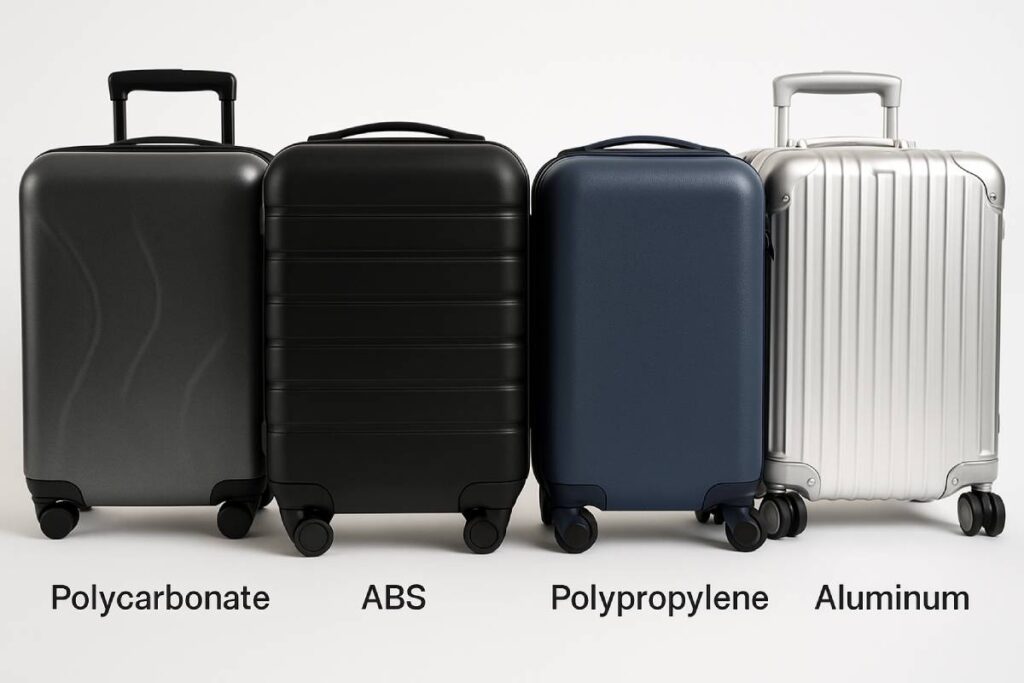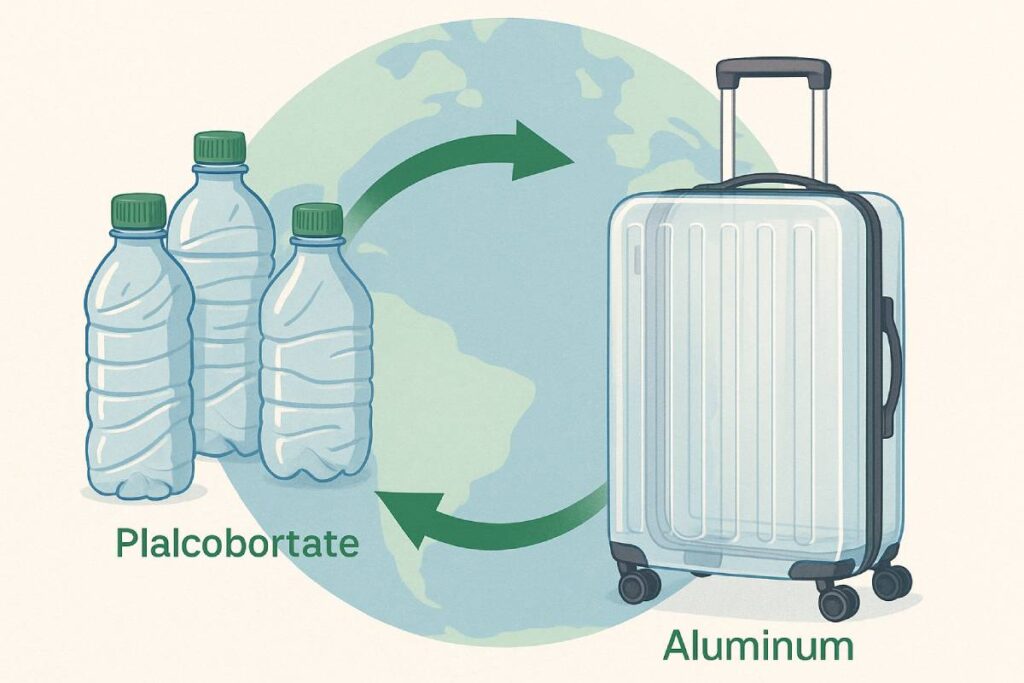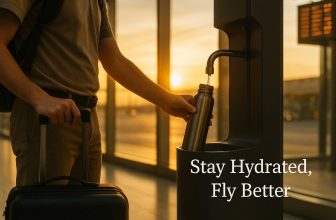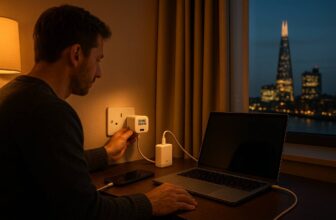Packing for travel often feels like a tug-of-war between durability, weight, and budget—and your choice of carry-on material sits at the heart of that balance.
From polycarbonate’s bend-but-don’t-break resilience to aluminum’s tank-like integrity, each shell option carries unique trade-offs in weight and cost.
Meanwhile, budget-friendly fabrics like ballistic nylon and polyester deliver flexibility and lightness—albeit with lower impact resistance.
Today’s travelers also demand sustainability: recycled-polycarbonate shells and circular-economy programs are rising stars.
Let’s dive into the specs and real-world insights that will help you choose the perfect carry-on companion.
Overview of Common Carry-On Materials
Choosing the right carry-on material means balancing weight, durability, and budget. Polycarbonate offers excellent impact resistance at ~3.1–3.6 kg for a 22″ spinner.
ABS blends affordability and lightness (≈3.0–3.3 kg) but sacrifices some scratch resistance.
Polypropylene sits between ABS and polycarbonate in rigidity and flex, averaging 2.5–2.9 kg.
Aluminum cases deliver military-grade toughness at 5.0–5.5 kg. On the soft side, ballistic nylon offers tear resistance and weighs under 3.6 kg, while polyester fabrics are budget-friendly at 2.5–3.0 kg.
Finally, sustainable options like Paravel’s Re: Cove® (100% recycled polycarbonate) and new biodegradable textiles cater to eco-minded travelers.
Hard-Shell Options

Polycarbonate
Polycarbonate is a family of thermoplastic polymers produced via BPA-phosgene interfacial polymerization or transesterification, then formed through injection molding, extrusion, or thermoforming.
Its high impact strength (600–850 J/m Izod) and ability to flex without cracking make it a traveler’s favorite. Typical 22″ polycarbonate carry-ons weigh between 3.1 kg (Rimowa Essential Cabin S) and 3.6 kg (Travelpro Platinum Elite).
ABS
Acrylonitrile Butadiene Styrene (ABS) shells combine lightness with economy. Blended ABS+PC carry-ons often weigh 3.0–3.3 kg and resist scratches modestly, though they’re more prone to cracking than pure polycarbonate.
Polypropylene
Polypropylene offers better crack resistance and flexibility than ABS. A 20″ polypropylene spinner weighs 2.5 kg (5.51 lbs) and a 24″ model 3.3 kg (7.28 lbs), so a 22″ version generally sits around 2.8–3.0 kg.
Aluminum
Aircraft-grade aluminum shells deliver unrivaled dent resistance and longevity. However, that toughness comes at a weight premium—22″ aluminum carry-ons average 5.0–5.5 kg (11–12 lbs).
| Material | Typical Weight (22″) |
|---|---|
| Polycarbonate | 3.1 – 3.6 kg |
| ABS | 3.0 – 3.3 kg |
| Polypropylene | 2.5 – 2.9 kg |
| Aluminum | 5.0 – 5.5 kg |
Soft-Shell Options
Ballistic Nylon
Originally developed for flak jackets, 1680D ballistic nylon endures tears and abrasions that would ravage lesser fabrics. Tumi’s FXT ballistic nylon carry-ons are rated under 3.6 kg, combining flexibility with ruggedness.
Polyester
Polyester suitcases are budget champions. A Rick Steves 20″ polyester spinner weighs 2.95 kg (6½ lbs), while Travelpro Maxlite® 5’s eco-friendly polyester model tips 2.45 kg (5.4 lbs).
| Material | Typical Weight (22″) |
|---|---|
| Ballistic Nylon | < 3.6 kg |
| Polyester | 2.5 – 3.0 kg |
Sustainable Materials
- Recycled Polycarbonate (Paravel Re:Cove®): 100% post-consumer recycled by upcycling water-cooler tanks into ultra-light, impact-resistant shells.
- Biodegradable Fabrics: Emerging options include linen (fully compostable flax fibers) and bio-based polyesters certified for industrial composting, offering a guilt-free end-of-life.
By understanding these material trade-offs—rigidity vs. weight, cost vs. longevity—you can pick the perfect carry-on for your travel style. Compare top-rated luggage in each material category to make an informed choice today!
Durability Comparison
Hard-shell materials like polycarbonate and aluminum lead the pack in lab‐tested impact resilience, absorbing 600–850 J/m and exceeding 900 J/m, respectively, before failure.
ABS scores a moderate 200–300 J/m, while polypropylene lands around 500–600 J/m in Izod tests. Surface hardness (Rockwell R) underpins scratch resistance: polycarbonate clocks 72–126 HRR, ABS 68–118, and polypropylene 80–110.
Weather resilience varies: polycarbonate survives –40 °C to +115 °C with <0.2 % water uptake; ABS tolerates –20 °C to +97 °C but absorbs ~2 % moisture; polypropylene endures to 82 °C with virtually zero water ingress. Soft-shell ballistic nylon features PU coatings for water repellency and UV inhibitors, while polyester offers budget-friendly, quick-dry performance.
Below, we break down each durability metric and then rank materials on a ★★★★★ scale using UUH and FTL brand tech specs.
Impact Resistance
- Polycarbonate dominates drop tests with an Izod Impact Strength of 600–850 J/m, flexing under high‐energy impact rather than cracking.
- ABS hard-shells average 200–300 J/m, enough to survive typical baggage handling but prone to brittle failure under extreme stress.
- Polypropylene registers 500–600 J/m (non-notched), balancing flexibility with shock absorption.
- Aluminum frames exceed 900 J/m in non-notched metal tests, rendering them virtually dent-proof in most drop scenarios.
Scratch & Abrasion Resistance
- Polycarbonate surfaces rate 72–126 HRR (Rockwell R), meaning light scratches won’t propagate into cracks.
- ABS scores 68–118 HRR, showing good initial scratch resistance but lower toughness under repeated abrasion.
- Polypropylene spans 80–110 HRR, offering a semi-rigid barrier that flexes before scratching.
- Aluminum alloy shells (anodized) sit around 60–70 HRB, resisting surface gouges but showing dents more visibly.
- Ballistic Nylon (1050–1680 D) uses a tight basket weave and PU coating to shrug off abrasion, rated Shore D 75 for fabric hardness.
- Polyester soft-shells measure Shore D 50–60, making them cost-effective but more prone to scuffing.
Weather Resistance
- Polycarbonate holds up from –40 °C to +115 °C; water uptake is <0.2 % after 24 h, though long-term UV exposure requires stabilizers.
- ABS remains functional between –20 °C and +97 °C, but ~2 % water absorption and UV‐induced yellowing can degrade appearance over time.
- Polypropylene resists moisture ingress (<0.01 %) and works up to 82 °C, though UV stabilizers are recommended for outdoor use.
- Aluminum resists corrosion and UV by nature; anodized finishes safeguard against moisture and high temperatures beyond 150 °C.
- Ballistic Nylon fabrics, when PU-coated, repel water and block UV; rated for –30 °C to +80 °C in outdoor gear specs.
- Polyester dries quickly, tolerates –20 °C to +70 °C, and holds up under light rain with DWR coatings.
Durability Ratings Table (Brand Tech Specs)
| Material | UUH Tech-Spec Rating | FTL Brand Rating |
|---|---|---|
| Polycarbonate | ★★★★★ – “Highly impact-resistant, flexible, prevents cracking” | ★★★★★ (4.9/5) |
| ABS | ★★★★☆ – “Absorbs shocks, lightweight, durable for typical travel” | ★★★★★ (4.9/5) |
| Polypropylene | ★★★★☆ – “Flexible, crack-resistant, mid-weight” | ★★★★★ (4.9/5) |
| Aluminum | ★★★★★ – “Aerospace-grade, top-tier impact resistance, corrosion-proof” | ★★★★★ (4.9/5) |
| Ballistic Nylon | ★★★★☆ – “Exceptional tear & abrasion resistance; water-repellent PU coating” | ★★★★★ (4.9/5) |
| Polyester | ★★★☆☆ – “Budget-friendly, quick-dry, moderate durability” | ★★★★★ (4.9/5) |
By comparing lab‐tested impact and scratch resistance, real-world weather performance, and brand durability specs from UUH and FTL, you now have a clear picture of which carry-on material best fits your travel style and budget.
Weight Comparison
On average, polycarbonate carry-ons weigh between 5.07 and 8.4 lbs (2.3–3.8 kg), while ABS shells sit around 7.5 lbs (3.4 kg), and polypropylene options average 5.34 lbs (2.42 kg). Aluminum hardshells are the heaviest at roughly 11 lbs (5 kg). Soft-side bags run lighter: ballistic nylon is usually under 8 lbs (< 3.6 kg), and polyester spans about 6.5 lbs (2.95 kg).
Hard-Shell vs. Soft-Shell
- Polycarbonate carry-ons typically range from 5.07 lbs (e.g. Samsonite UpLIFT) to 8.4 lbs (Business Insider’s top pick).
- ABS hardshells average 7.5 lbs, offering a durable yet slightly heavier profile than polypropylene.
- Polypropylene models like American Tourister’s Air Move weigh in at 5.34 lbs, making them the lightest rigid option.
- Aluminum carry-ons clock around 11 lbs, prized for rugged dent-proof shells but at a weight premium.
- Ballistic nylon soft-sides stay under 8 lbs, combining toughness with ease of carry.
- Polyester bags (e.g., Herschel Heritage) hover near 6.5 lbs, balancing cost and lightness.
Practical Implications
- Bags under 6 lbs (e.g., polypropylene, lightweight polycarbonate) dramatically reduce strain when lifting into overhead bins and speed up gate-to-seat transitions.
- At 5.07 lbs, the Samsonite UpLIFT was praised for “effortless stowing” in overhead compartments during Travel + Leisure’s durability tests.
- Heavier aluminum models (≈ 11 lbs) often require two-handed lifts and can push travelers closer to airline weight limits, risking gate-checks.
- Soft-side fabrics like ballistic nylon offer more “give” when sliding into bins or fitting into tight overhead spaces, enhancing maneuverability.
Weight Ranges Chart
| Material | Weight Range (22″ Carry-On) |
|---|---|
| Polycarbonate | 5.07 – 8.4 lbs (2.3 – 3.8 kg) |
| ABS | 7.5 lbs (3.4 kg) |
| Polypropylene | 5.34 lbs (2.42 kg) |
| Aluminum | 11 lbs (5 kg) |
| Ballistic Nylon | < 8 lbs (< 3.6 kg) |
| Polyester | 6.5 lbs (2.95 kg) |
Data compiled from Samsonite, Rockland, American Tourister, Travel + Leisure, and Herschel product specs.
Price Range Implications
Entry-Level ABS and polyester carry-ons generally cost $50–$100, with budget-friendly hardside options like the Amazon Basics Expandable Hardside at $63 and soft-shell polyester picks such as the American Tourister Phenom at $89.99.
Mid-range polypropylene and polycarbonate models span $100–$300, striking a balance between durability and affordability—think LARVENDER’s PP hardshell set at $179.99 or Zappos’s Meridian polycarbonate spinner at $170.
Premium aluminum and ballistic nylon carry-ons start around $700 and can exceed $1,500, with the RIMOWA Essential Lite Cabin at $700 and Tumi’s FXT ballistic nylon option listed at $875.
Material choice also drives the cost per kilogram—budget ABS cases at $57.11 for 3.4 kg averaging about $17/kg, whereas a RIMOWA Original Cabin aluminum model at $1,400 for 4.3 kg works out to roughly $326/kg.
| Tier | Materials | Price Range |
|---|---|---|
| Entry-Level | ABS, Polyester | $50 – $100 |
| Mid-Range | Polypropylene, Polycarbonate | $100 – $300 |
| Premium | Aluminum, Ballistic Nylon | $300 – $800+ |
Entry-Level: ABS and Polyester ($50–$100)
For travelers watching every pound and penny, ABS and polyester carry-ons deliver basic protection and style for under $100. Hardside ABS cases like the Travelers Club Chicago spinner retail for $57.11 on Amazon, making them a smart buy for occasional flyers.
On the soft-side, polyester spinners such as the American Tourister Phenom at $89.99 from Target offer ZIP pockets and external organization without breaking the bank.
Mid-Range: Polypropylene and Polycarbonate ($100–$300)
When you need bounce-back toughness and a bit more tech, polypropylene and polycarbonate options fill the sweet spot. Mid-tier polypropylene sets like LARVENDER’s 5-piece collection clock in around $179.99, blending lightness with crack resistance.
For sleek, impact-resistant shells, polycarbonate spinners such as the Zappos Meridian Carry-On at $170 provide flex-and-repair capabilities that earn traveler praise.
Premium: Aluminum and Ballistic Nylon ($300–$800+)
Frequent fliers and style mavens often gravitate to aluminum and ballistic nylon—materials built to last a lifetime. Mid-tier aluminum shells like the RIMOWA Essential Lite Cabin start at $700, offering anodized finishes and anti-corrosion benefits.
On the textile front, Tumi’s FXT ballistic nylon carry-on lists at $875, combining military-grade fabric with smooth spinner wheels and premium hardware.
How Material Drives Cost per Kilogram
Material selection not only shapes durability but also affects cost density. For example, a 3.4 kg ABS spinner at $57.11 works out to about $17/kg, while a 4.3 kg RIMOWA Original Cabin at $1,400 translates to $326/kg. In short, each extra ounce of high-end material comes with a steeper price tag—choose wisely based on your travel style and budget.
Real-World Performance Insights
Real-world testing and traveler feedback reveal that even the toughest materials face unique stresses on the move—Travelpro’s Platinum Elite carried 7.8 lb of gear across uneven ranch terrain without a hitch, while third-party testers rave about its “buttery smooth” wheels, handles, and zippers after hundreds of miles.
Frequent flyers note that a bit of handle wobble prevents binding, but waterproof zipper coatings can wear under UV exposure. Corporate road warriors stick with brands offering lifetime warranties and low downtime, budget vacationers praise sub-$200 ABS spinners for tackling cobblestones, and students favor lightweight polyester soft-sides with extra pockets for daily hops around campus.
Brand-Specific Durability Anecdotes
- Travelpro Platinum Elite Ranch Test: The New York Post reports that the Platinum Elite Hardside Spinner, weighing 7.8 lb, was spun across rugged Texas ranch terrain with no shell cracks or wheel failures.
- OutdoorGearLab Endurance Trial: In controlled lab and field tests, OutdoorGearLab found its wheels, handles, and zippers remained “buttery smooth” even after repeated obstacle-course simulations.
- Good Housekeeping Obstacle Course: Good Housekeeping testers ran Platinum Elite bags through airport-style challenges—including conveyor-belt dumps and curbside drops—and praised their unyielding rigidity and minimal scuff marks.
Frequent-Flyer Feedback
- Handle Wobble: FlyerTalk members agree that slight handle play reduces internal binding and prolongs tube life, though some travelers equate wobble with flimsy construction.
- Zipper Longevity: Reddit users observing waterproof TPU-coated zippers warn that prolonged sun exposure can peel coatings; they recommend packing cubes and gentle handling to extend zipper lifespan.
- Rigidity and Shape Retention: Long-term reviewers note polycarbonate shells—especially those with textured finishes—keep their shape through tight overhead bins, while soft-side ballistic nylon offers forgiving compression when bins are overstuffed.
Case Studies: Traveler Segments
| Segment | Preferred Material & Brand | Real-World Insight |
|---|---|---|
| Business Travelers | Travelpro Platinum Elite (polycarbonate hardshell) | Egencia corporate case studies highlight that Road Warriors demand luggage with lifetime warranties and minimal repair downtime. |
| Budget Vacationers | American Tourister / Amazon Basics (ABS hard-shell) | Rick Steves forum contributors praise ~$200 ABS spinners for enduring cobblestone streets and light drops without deformation. |
| Students & Young Pros | Herschel Heritage (polyester soft-side) | Travel + Leisure testers note polyester spinners under 7 lb combine campus-friendly lightness with front pockets for books and chargers. |
These real-world insights bridge the gap between lab specs and actual travel experiences—helping you choose carry-ons that not only look good on the shelf but survive the tarmac, the terminal, and beyond.
Maintenance & Care Requirements
Keeping your carry-on in top shape not only extends its lifespan but also ensures smooth travel. For hard-shell cases, gentle scratch removal with melamine foam, UV-safe storage in a dark closet or protective cabinet, and periodic zipper lubrication keep shells pristine and zippers snag-free.
Soft-shell fabrics benefit from spot-cleaning with mild detergent, thorough drying to prevent mold, and annual Scotchgard® treatments for water repellency. Aluminum‐frame carry-ons demand special attention: glue-pull dent-repair kits for dings and careful polishing with aluminum polish to restore that signature gleam.
Hard-Shell Care
Scratch-Removal Tips
- Melamine foam (e.g., Mr. Clean Magic Eraser) buffs out scuffs on polycarbonate or ABS without harsh chemicals—test a hidden spot first.
- Eraser cleaning pads designed for luggage gently remove marks; avoid acetone, ammonia, and benzene compounds that can damage your shell.
UV-Safe Storage
- Store hard-shell cases in a cool, dark closet or a UV-resistant cabinet to prevent brittleness and color fading over time.
- For extra sanitation, a UV-C sanitizing box can keep handles and trims germ-free—ideal before long trips.
Seam & Zipper Lubrication
- Use a purpose-made zipper lubricant (e.g., Zipper Ease) by running the wax stick along teeth—this works on metal and plastic zippers alike.
- In a pinch, household aids like graphite pencils, lip balm, or olive oil can restore smooth action—wipe away residue afterward.
- Frequency: Lubricate zippers every 3–6 months, or before a heavy-use season, to avoid stuck sliders and fabric snags.
Soft-Shell Care
Spot-Cleaning
- Mix 1 tbsp mild laundry detergent into 8 oz warm water, then gently blot stains with a soft cloth or brush—never scrub aggressively.
- Wipe away soap residue with a clean damp cloth, then air-dry fully in sunlight or a ventilated area.
Mold & Mildew Prevention
- After any cleaning, ensure 100 % dryness—store with silica gel packets and avoid damp basements to stop mold growth.
- For existing mildew, spray a 50/50 white vinegar–water solution, let sit 10 min, then rinse and dry thoroughly.
Fabric Protector Sprays
- Apply Scotchgard™ Fabric Water Shield in two light, overlapping coats from 15 cm away; let each coat dry fully before use.
- Reapply after any deep cleaning or at least once a year to maintain stain and water repellency.
Aluminum Specifics
Dent Repair Kits
- Glue-pull kits (e.g., Dent Fix from Auto Body Toolmart) let you gently pop out small aluminum dings—no paint damage is required.
- For stubborn dents, a 1500 W induction heater kit uses heat to expand metal back into place—professionals often favor these for consistent results.
Polishing Procedures
- Clean first with mild soap and water; wipe off residue and dry with a soft microfiber cloth.
- Polish using a small dab of aluminum polish on a soft cloth; buff in gentle circular motions until the metal gleams.
- For brushed or satin finishes, follow manufacturer-recommended non-abrasive polishes to preserve texture and avoid swirl marks.
Maintenance Tools & Products at a Glance
| Care Category | Recommended Product | Purpose |
|---|---|---|
| Scratch Removal | Melamine foam pad | Buff out scuffs & light scratches |
| Zipper Lubrication | Zipper Ease wax stick | Smooth zipper operation |
| Fabric Protection | Scotchgard™ Fabric Water Shield | Repel liquids & stains |
| Dent Repair | Dent Fix glue-pull kit | Remove small dents without paint damage |
| Aluminum Polishing | Aluminum polish (e.g., Autosol) | Restore shine & finish |
Follow these expert care steps to keep your carry-on luggage looking new trip after trip.
TSA Compliance & Airline Restrictions
Most airlines cap carry-on dimensions at 22″×14″×9″ (45 linear inches) to fit overhead bins and sizers effortlessly.
While many U.S. carriers don’t enforce a strict weight limit—focusing instead on the traveler’s ability to stow unassisted—international and budget airlines commonly impose 7–10 kg caps (e.g., Emirates 7 kg, Singapore 7 kg, Lufthansa 8 kg).
To dodge surprise gate-check fees, weigh your packed bag at home: a portable luggage scale hooks onto the handle for pinpoint accuracy, or you can use a bathroom scale to measure yourself with and without the bag, subtracting your body weight.
Below, you’ll find detailed specs, a quick reference table, and smart hacks to stay under the limit.
Standard Carry-On Dimensions
Airlines in the U.S. and many international routes set the maximum carry-on at 22 inches tall × 14 inches wide × 9 inches deep, totaling 45 linear inches. This measurement includes wheels and handles and ensures your bag fits standard sizers at the gate. Stick to these dimensions to avoid involuntary gate checks and extra fees.
Weight Limits
Domestic U.S. airlines typically don’t specify a weight cap for carry-ons, instead requiring that passengers be able to lift their bags into the overhead bin unassisted. However, many major international and low-cost carriers enforce 7–10 kg limits:
| Airline | Weight Limit | Dimensions (in) |
|---|---|---|
| Emirates | 7 kg | 22 × 15 × 8 |
| Singapore Airlines | 7 kg | 22 × 16 × 8 |
| Lufthansa | 8 kg | 22 × 16 × 9 |
| British Airways | 23 kg | 22 × 18 × 10 |
| KLM Royal Dutch Airlines | 12 kg | 22 × 16 × 9 |
Source: Globite Travel International Luggage Guide.
Many European carriers like Aer Lingus also set 7–10 kg limits, so always check before you fly. If you exceed these caps on budget fares, expect a gate-check fee of €20–€50 or more.
Tips to Weigh at Home and Avoid Gate-Check Fees
Packing smarter means pre-weighing your luggage. Here’s how:
| Method | Pros | Cons |
|---|---|---|
| Portable Luggage Scale | Highly accurate; shows lbs & kg; under $20 USD | Extra item to carry |
| Bathroom Scale Trick | No additional cost; easy household tool | Slightly less precise |
| Built-In Suitcase Scale | Instant readout; always onboard | Premium bags only; higher cost |
- Portable Luggage Scale: Hook it onto your packed handle, lift it, and read your exact weight—no surprises at check-in.
- Bathroom Scale Method: Weigh yourself first, then hold the packed bag and weigh it again. Subtract your body weight to get bag weight.
- Built-In Scales: Some premium brands (e.g., Away’s ActR™ built-in scale) give immediate readings—ideal for frequent flyers.
- Final Check: Aim for at least 1 kg under your airline’s limit to account for scale variances and last-minute additions.
By adhering to the 22×14×9″ dimensions and staying within 7–10 kg (or your airline’s specific cap), you’ll glide through boarding without gate-check hiccups—and avoid those dreaded extra fees. Safe travels!
Sustainability & Eco-Friendliness
Switching from virgin ABS to recycled polycarbonate can cut a carry-on’s cradle-to-gate carbon footprint by up to 67%, conserving oil feedstocks and reducing GHG emissions by –67 Mt CO₂e globally when scaled

Brands like Paravel go further—offsetting every Aviator’s emissions and upcycling millions of plastic bottles—while Away enriches circularity through its “Give Back Box” program and rising recycled content in its Classic line.
Lifecycle Analysis: Recycled Polycarbonate vs. Virgin ABS
A cradle-to-gate life-cycle assessment shows recycled polycarbonate (rPC) shells emit 67 %–98 % less CO₂ per cm³ compared to virgin polycarbonate—and likewise outperform virgin ABS by a similar margin.
Mechanical recycling of polycarbonate not only saves 24 % in life-cycle energy demand but also reduces GHG emissions by 27 % versus zero-recycling scenarios. In contrast, producing virgin ABS resin from petroleum incurs higher emissions—up to 85 % more CO₂ per kilogram than rPC production.
| Metric | Recycled Polycarbonate | Virgin ABS |
|---|---|---|
| CO₂e Emissions (cradle-to-gate) | –67 % vs. virgin resins | Baseline (100 %) |
| Energy Demand Reduction | –24 % vs. zero recycling | Baseline |
| Water & Resource Depletion Savings | Significant (mechanical recycling) | High water & petrochemical use |
Brand Spotlight: Paravel’s Carbon-Neutral Production
- First Carbon-Neutral Suitcase: Paravel’s Aviator shell is 100 % rPC, made from upcycled water-cooler tanks, and certified carbon-neutral—offsetting sourcing, manufacturing, shipping, and even the buyer’s inaugural flight.
- Upcycled Components: PET lining from 15 post-consumer bottles and recycled PVB zippers reinforce their circular approach.
- Impact to Date: Over 7.5 million plastic bottles recycled, 550,000 trees planted, and 24,000 t CO₂ offset via Eden Reforestation Projects.
Brand Spotlight: Away’s Material Take-Back Programs
- Give Back Box: Away’s mail-in program lets you donate functional luggage to charity—prepaid labels included, fostering social impact and waste diversion.
- Rising Recycled Content: Their Classic collection now integrates PCR plastics in shells, liners, and packaging, with all exterior cartons 100 % recyclable.
- Future Goals: Away aims to halve virgin material use in upcoming collections and achieve full circularity across all product lines.
By choosing recycled plastic carry-ons and supporting circular-economy brands, you can travel confidently, knowing your gear treads lightly on the planet.
Warranty & After-Sales Support
Extended warranties can turn a suitcase from a one-trip companion into a lifelong travel ally.
Monos backs every piece with a true lifetime warranty—no purchase registrations, no hidden clauses—and was even named “Best Overall” for its Lifetime Warranty by a former travel editor at the New York Post. Samsonite, meanwhile, extends limited lifetime coverage on its premium Curv® collections (Cosmolite, Black Label Lite-Shock) and a three-year global warranty on most other lines, guarding against manufacturing defects in materials and workmanship.
Lifetime Warranties: Monos & Samsonite
Monos
All Monos carry-ons come with a Lifetime Warranty for the original owner, automatically covering:
- Wheels that stop spinning or break under normal use
- Telescopic handles that jam or won’t extend
- Locks & zippers that no longer function as intended
For travelers wanting even broader protection—against airline damage, lost luggage, or zipper mishaps—Monos offers optional Essential and Pro coverage add-ons.
Samsonite
- Premium Curv® Collections (Cosmolite, Lite-Shock): Limited Lifetime Warranty on shell cracks, wheel failures, handle breakages, and zipper faults for the first purchaser.
- Most Samsonite Lines: 3-Year Limited Global Warranty covering manufacturing defects in materials and workmanship. Misuse, airline damage, and normal wear & tear are not covered.
Limited Warranties: ABS & Polypropylene Brands (2–5 Years)
Many budget-minded hardshell makers cap their warranties between 2 and 5 years, reflecting the lower cost and expected lifespan of ABS and polypropylene shells:
- Delsey offers a 2-Year Limited Warranty on ABS/polypropylene suitcases, covering defects in materials and workmanship (cracks, separation) but excluding damage from misuse or airlines.
- AmazonBasics provides a 3-Year Limited Warranty against defects under ordinary use; after that, repairs or replacements are at their discretion. Cosmetic issues, abuse, and airline mishandling are excluded.
Tip: Always read the fine print—most limited warranties exclude “normal wear & tear,” impacts from conveyor belts, and cosmetic scratches.
What Warranties Cover (By Material & Brand)
| Material & Brand | Warranty Length | Covered Components | Exclusions |
|---|---|---|---|
| Polycarbonate — Monos | Lifetime | Wheels, handles, locks, zippers | Cosmetic scratches, airline baggage fees |
| Curv® (ABS/PC) — Samsonite | Limited Lifetime | Shell cracks, wheels, handles, zippers | Misuse, airline damage, normal wear & tear |
| ABS/PP — Delsey | 2 Years | Cracks, material defects, zipper malfunctions | Cosmetic dents, airline damage, abuse |
| ABS — AmazonBasics | 3 Years | Defects in materials & workmanship | Cosmetic damage, misuse, airline mishandling |
By aligning warranty length and coverage with your travel habits—light commuter versus globe-trotting road warrior—you can choose luggage that not only withstands the rigors of the journey but also ensures peace of mind long after takeoff.
Conclusion
Choosing the ideal carry-on material boils down to matching your travel habits with the right performance profile.
Polycarbonate wins for those who face rough baggage handling yet need a manageable weight—its shells flex under impact rather than crack.
ABS and polypropylene offer a wallet-friendly entry point, trading off some toughness for sub-€100 price tags and feather-light heft.
Aluminum stands unmatched in raw durability but at the cost of heavier lifts and steeper price points. In soft-sided bags, ballistic nylon affords exceptional tear resistance, while polyester suits the occasional traveler prioritizing cost and color variety.
Maintenance nuances—from scratch removal on hard shells to mildew-proofing soft fabrics—ensure your investment outlasts countless layovers.
Airline size and weight limits (22 × 14 × 9″ and 7–10 kg on many international carriers) shape your material choice, too. And for eco-minded flyers, recycled-plastic carry-ons and manufacturer take-back schemes are more than greenwashed buzzwords—they’re real steps toward circular travel gear.
Armed with these insights, you can confidently “Compare top-rated luggage in each material category” and find the perfect balance of durability, weight, budget, and sustainability for your next adventure.
FAQs
1. What’s the strongest hard-shell material?
Polycarbonate ranks highest for impact resistance (600–850 J/m Izod), flexing under pressure instead of cracking.
2. Is a soft-shell bag more lightweight?
Yes—polyester soft-sides can be as light as 2.5 kg, while ballistic nylon stays under 3.6 kg with premium tear resistance.
3. How do I avoid airline weight limits?
Aim for a sub-6 kg hard-shell (polypropylene or lightweight polycarbonate) and weigh with a portable scale before departure.
4. Are recycled-plastic carry-ons any good?
Recycled polycarbonate shells cut CO₂ emissions by up to 67 % versus virgin ABS, with comparable durability.
5. What warranty should I look for?
Lifetime coverage on Monos and Samsonite Curv® collections protects wheels, handles, zippers, and shell cracks under normal use.





